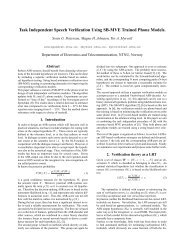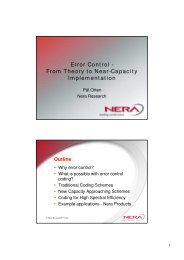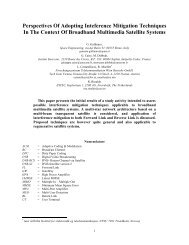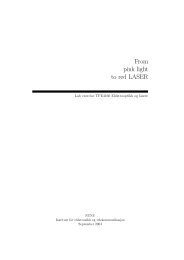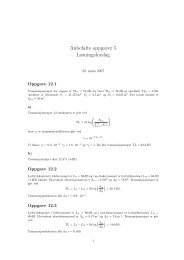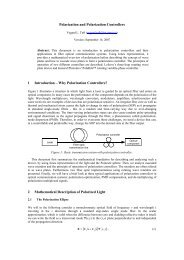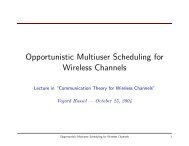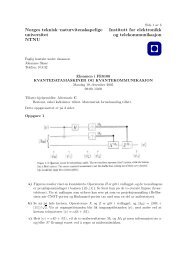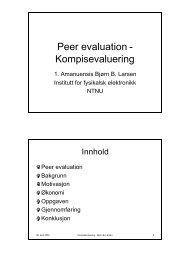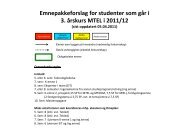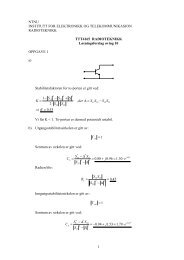THE OPTIMAL WEIGHTS OF A MAXIMUM RATIO ... - NTNU
THE OPTIMAL WEIGHTS OF A MAXIMUM RATIO ... - NTNU
THE OPTIMAL WEIGHTS OF A MAXIMUM RATIO ... - NTNU
You also want an ePaper? Increase the reach of your titles
YUMPU automatically turns print PDFs into web optimized ePapers that Google loves.
<strong>THE</strong> <strong>OPTIMAL</strong> <strong>WEIGHTS</strong> <strong>OF</strong> A <strong>MAXIMUM</strong> <strong>RATIO</strong> COMBINER USING<br />
AN EIGENFILTER APPROACH<br />
Bengt Holter, Geir E. Øien<br />
Norwegian University of Science and Technology<br />
Department of Telecommunications<br />
O.S.Bragstads plass 2B, N-7491 Trondheim, Norway<br />
{bholter,oien}@tele.ntnu.no<br />
ABSTRACT<br />
This letter presents an eigenfilter approach to obtain<br />
the optimal weights of a diversity receiver using maximum<br />
ratio combining (MRC). It is shown that the optimal<br />
weights correspond to a matched filter solution<br />
for stochastic signals and that the optimal weights are<br />
the same regardless of the signal branch correlation.<br />
1. INTRODUCTION<br />
Maximum ratio combining (MRC) is the optimum<br />
spatial diversity strategy to reduce the signal fluctuations<br />
caused by multipath propagation in wireless<br />
communications. By definition, a MRC combiner linearly<br />
combines the individually received branch signals<br />
so as to maximize the instantaneous output signalto-noise<br />
ratio (SNR). In a recent letter by Dong and<br />
Beaulieu [1], it was proved that a MRC combiner operating<br />
on correlated branches is optimal even if the<br />
branch signals are weighted as though they were independent.<br />
A decorrelation approach was used to show<br />
that the expressions for the signal envelope and the<br />
SNR were the same regardless of the signal branch<br />
correlation. In this letter, it is shown that there is<br />
actually no need to look at the correlation between<br />
the branches at all to establish this statement. The<br />
optimal weights of a MRC combiner is optimal (in<br />
a signal-to-noise ratio sense) regardless of the signal<br />
branch correlation due to the optimization of the instantaneous<br />
SNR instead of the average SNR. The<br />
optimal weights originally derived in [2] by using the<br />
Schwarz inequality are obtained in this letter by means<br />
of an eigenfilter approach.<br />
2. CHANNEL MODEL<br />
In general, the wireless channel between n T transmit<br />
antennas and n R receive antennas can be represented<br />
by a channel matrix H written as<br />
⎡<br />
⎤<br />
h 11 ··· h 1nT<br />
h 21 ··· h 2nT<br />
H = ⎢ .<br />
⎣<br />
.<br />
. ..<br />
. ⎥<br />
. ⎦ . (1)<br />
h nR1 ··· h nRn T<br />
For a narrowband flat-fading channel, a general entry<br />
of the channel matrix is denoted by<br />
h ij = α + jβ<br />
= √ α 2 + β 2 · e −j arctan β α<br />
= |h ij |·e jφij , (2)<br />
where |h ij | represents the fading envelope of the narrowband<br />
channel between the jth transmitter and the<br />
ith receiver. If both α and β are zero-mean, independent,<br />
and normally distributed random variables, h ij<br />
is a zero-mean, complex, normally distributed random<br />
variable with a fading envelope |h ij | following a<br />
Rayleigh distribution. For non-line-of-sight (NLOS)<br />
transmission, it is common to assume all the entries<br />
of the channel matrix as (possibly correlated) complex<br />
random variables with Rayleigh distributed envelopes<br />
[3]. For the special case of n T = 1, the channel matrix<br />
is reduced to a column vector. Denoting the transmitted<br />
(stochastic) complex baseband signal at time<br />
index k ∈{0, 1, 2 ...} by x(k), the received signal at<br />
antenna i ∈{1, 2,... ,n R } can be written as<br />
s i (k) =h i (k)x(k)+n i (k). (3)<br />
In (3), h i (k) represents the time-varying complex channel<br />
gain between a single transmit antenna and the<br />
ith receive antenna at time index k. The complexvalued<br />
additive white gaussian noise (AWGN) is denoted<br />
n i (k) and is modelled as a complex zero-mean<br />
normally distributed random variable. It is assumed<br />
that n i (k) is independent of h i (k). Using vector notation,<br />
the received signal vector at time instant k may<br />
be expressed as<br />
s(k) =h(k)x(k)+n(k), (4)
where s(k), h(k), and n(k) are all column vectors. For<br />
notational convenience, data associated with time k<br />
will from now on be indicated by subscripts, such as<br />
s k , h k ,andn k . In the next section, an eigenfilter<br />
approach is used to obtain the optimal linear combination<br />
of the entries of s k in order to maximize the<br />
output SNR.<br />
3. EIGENFILTER APPROACH<br />
With a linear combining technique, the output of the<br />
maximum ratio combiner at time instant k may be<br />
expressed as<br />
y k = w H s k (5)<br />
= w H h k x k + w H n k , (6)<br />
where w ∈ C nR are the (as yet unknown) weights<br />
of the linear combiner and the superscript H denotes<br />
Hermitian transpose. In a fading channel, the received<br />
SNR level will vary due to random fluctuation<br />
of the signal power. This random fluctuation is described<br />
by the fading envelope |h ij |. In this letter, the<br />
fading envelopes associated with the separate antenna<br />
branches are represented by the entries of the channel<br />
vector h. In general, the channel vector h is treated<br />
as a multivariate random variable with possibly correlated<br />
entries. However, the current (observed) channel<br />
vector at time instant k is always treated as a<br />
single channel realization of the random variable h.<br />
Invoking this assumption together with the assumption<br />
of an average transmit power P T ,theinstantaneous<br />
received signal power S at the output of the<br />
MRC combiner at time instant k can be expressed as<br />
S = P T · w H h k h H k w. (7)<br />
The expected output noise power N may be expressed<br />
as<br />
N = E{|w H n| 2 } = w H R n w, (8)<br />
where R n = E{nn H }. Using (7) and (8), the instantaneous<br />
output SNR from the MRC at time instant k<br />
can be expressed as<br />
γ k,MRC = S N = P T · w H h k h H k w<br />
w H R n w<br />
= P T · w H ˆR k w<br />
w H R n w , (9)<br />
where ˆR k = h k h H k<br />
. Note that the numerator in (9)<br />
represents the output signal power for a single observed<br />
channel realization h k of the random variable<br />
h at time instant k. The optimization problem is now<br />
to determine the coefficient vector w so as to maximize<br />
the instantaneous output SNR for the current<br />
observed channel vector h k . In the next two subsections,<br />
the optimum weight vector solution for both<br />
equal and unequal branch noise powers will be derived.<br />
3.1. Equal noise power<br />
In the following, we assume equal noise power at each<br />
of the branches, and also that the noise is uncorrelated<br />
between the branches. This means that the noise correlation<br />
matrix introduced in the previous section can<br />
be represented as R n = σ 2 I,whereσ 2 represents the<br />
noise power common to all branches and I represents<br />
the identity matrix. Taking the conjugate derivative<br />
∂/∂w ∗ [4] of (9) with respect to the weight vector w,<br />
we obtain the following set of implications:<br />
∂γ k,MRC<br />
∂w ∗ = 0<br />
⇕<br />
P T · ˆR k w(σ 2 w H w) = σ 2 w(P T · w H ˆRk w)<br />
⇓<br />
ˆR k w =<br />
(<br />
)<br />
w H ˆRk w<br />
w H w. (10)<br />
w<br />
Introducing λ = wH ˆRk w<br />
w H w<br />
and using the result of (10)<br />
in (9), we obtain<br />
γ k,MRC = P T · w H ˆRk w<br />
σ 2 w H w<br />
= P T · w H λw<br />
σ 2 w H w<br />
= P T · λ<br />
σ 2 .<br />
(11)<br />
It can be seen that the maximum value of the output<br />
PT ·λmax<br />
SNR is given as<br />
σ<br />
,whereλ 2<br />
max is the largest<br />
eigenvalue of the matrix ˆR k . The optimal weight vector<br />
that yields the maximum output SNR is given by<br />
the eigenvector associated with λ max . To obtain a<br />
non-trivial solution of (10), w must reside within the<br />
column space (range) of ˆR k , denoted R( ˆR k ). Since<br />
all the columns in ˆR k are linear combinations of the<br />
single vector h k , it is a rank one matrix and R( ˆR k )=<br />
{h k }.SinceR( ˆR k ) consists of just a single vector, the<br />
only way of obtaining a non-trivial solution is to select<br />
w opt = c · h k for an arbitrary c ≠ 0. Inserting<br />
this result into the left side of (10), we obtain<br />
||h k || 2 c · h k = λ max w opt . (12)<br />
The maximum eigenvalue is thus identified as λ max =<br />
||h k || 2 . Using this result in (11), the maximum output<br />
SNR is given by<br />
γ max<br />
k,MRC = P T ·||h k || 2<br />
σ 2 =<br />
n R<br />
∑<br />
i=1<br />
P T ·|h k,i | 2<br />
σ 2 =<br />
n R<br />
∑<br />
i=1<br />
γ k,i ,<br />
(13)<br />
where |h k,i | and γ k,i denote the fading envelope and<br />
the instantaneous SNR at the ith branch at time index<br />
k respectively. This result confirms that the output<br />
SNR may be expressed as a sum of the SNR values<br />
from the individual branches, which is a specific feature<br />
of the MRC combiner [2].
3.2. Unequal noise power<br />
With unequal noise power in the diversity branches,<br />
the SNR expressed in (9) can not be simplified. Taking<br />
the conjugate derivative of (9) with respect to the<br />
weight vector w, we obtain the following set of implications:<br />
∂γ k,MRC<br />
∂w ∗ = 0<br />
⇕<br />
P T · ˆR k w(w H R n w) = (P T · w H ˆRk w)R n w<br />
⇓<br />
ˆR k w =<br />
(<br />
w H ˆRk w<br />
w H R n w<br />
)<br />
R n w. (14)<br />
Introducing λ = wH ˆRk w<br />
w H R nw<br />
and exploit the fact that<br />
R n is nonsingular (diagonal matrix with all entries<br />
σi 2 > 0), (14) may be expressed as<br />
R −1<br />
n ˆR k w = λw. (15)<br />
The optimal weight vector is now the eigenvector of<br />
the matrix R −1 ˆR n k = R −1<br />
n h kh H k<br />
corresponding to the<br />
largest eigenvalue of the same matrix. By letting<br />
h ′ k<br />
= R−1 n h k, the current eigenvalue problem may<br />
be expressed as<br />
ˆR ′ kw = λw, (16)<br />
where ˆR ′ k = h′ k hH k . A non-trivial solution of this<br />
equation is obtained if w resides within the column<br />
space of ˆR′<br />
k , denoted R( ˆR ′ k ). Every matrix of the<br />
simple form h ′ k hH k has rank one [5] and the column<br />
space R( ˆR ′ k )={h′ k }. As in the previous section, the<br />
only choice to obtain a non-trivial solution is to select<br />
w opt = c · h ′ k for an arbitrary c ≠ 0. Inserting this<br />
result into the left side of (16), we obtain<br />
h H k R −1<br />
n h k c · h ′ k = λ max w opt , (17)<br />
and the maximum eigenvalue can be identified as λ max =<br />
h H k R−1 n h k . Inserting the optimal weight vector w opt =<br />
c · h ′ k = c · R−1 n h k into (9), we obtain<br />
γ max<br />
k,MRC = P T · h H k R −1<br />
n h k =<br />
n R<br />
∑<br />
i=1<br />
P T ·|h k,i | 2<br />
=<br />
σ 2 i<br />
n R<br />
∑<br />
i=1<br />
γ k,i ,<br />
(18)<br />
i.e., as in the previous subsection, the output SNR<br />
may be expressed as the sum of the SNR values from<br />
the individual branches. To summarize, we have obtained<br />
the following optimal weights:<br />
{<br />
hk Equal noise power<br />
w opt ∝<br />
R −1<br />
(19)<br />
n h k Unequal noise power<br />
Using these optimal weights, the maximum output<br />
SNR from a MRC combiner may be expressed as<br />
{<br />
γk,MRC max = P T ·||h k || 2<br />
σ<br />
Equal noise power<br />
2<br />
P T · h H k R−1 n h k Unequal noise power<br />
(20)<br />
Looking at the inner product in (5), the actual weights<br />
used in the inner product are the complex conjugate<br />
of the weights presented in (19). The optimal weights<br />
are then in agreement with the results presented in [2].<br />
Since the solutions in this section is linked to an eigenvalue<br />
problem, the optimal (spatial) filter obtained<br />
using this method is commonly called an eigenfilter.<br />
As noted in [4], the optimum filter characterized in<br />
this way may be viewed as the stochastic counterpart<br />
of a matched filter.<br />
4. INSTANTANEOUS VERSUS AVERAGE<br />
SNR<br />
In [1], it is stated that the optimal performance of<br />
a MRC diversity receiver can be achieved without<br />
decorrelating the correlated input signals, but weighting<br />
the input branch signals as though they were independent.<br />
This statement seems to indicate (i) the<br />
possible existence of several optimal weight solutions<br />
depending on signal branch correlation (ii) that the<br />
optimal weights must be obtained by incorporating<br />
the correlation properties in the optimizing procedure.<br />
However, in this letter, the optimal weight vector is<br />
shown to be the same as in the original paper by Brennan<br />
[2] without taking the correlation properties of h<br />
into account.<br />
Regarding assertion (ii), the way to incorporate<br />
the correlation properties into the optimizing procedure<br />
is to optimize the average SNR instead of the<br />
instantaneous SNR. If such an approach had been<br />
pursued in this letter, the eigenvalue problem would<br />
have contained the correlation matrix R h = E[hh H ]<br />
instead of the (instantaneous) matrix ˆR k = h k h H k .<br />
With the assumption of correlated branch signals however,<br />
R h would be a rank one matrix and the optimal<br />
weight vector solutions in (19) still apply. With<br />
the assumption of uncorrelated branch signals, R h is<br />
a diagonal (full rank) matrix and its eigenvalues are<br />
placed along its main diagonal. The optimal weight<br />
vector is still the eigenvector corresponding to the<br />
largest eigenvalue of the matrix R h . Assuming equal<br />
noise power in all branches for simplicity, the eigenvalues<br />
are equal to the individual channel powers. The<br />
solution is then to select the single channel realizing<br />
the largest channel gain. This selection scheme is<br />
commonly known as selection diversity and obviously,<br />
the results obtained by using average SNR are not in<br />
agreement with the results of MRC presented in [2].
Since the correlation properties of the channel vector<br />
h in this paper have no influence on the optimality of<br />
the weight vector solution, nor is there any need to<br />
perform the decorrelation approach suggested in [1]<br />
in order to establish the fact that performance measures<br />
of MRC combining are identical for both correlated<br />
and uncorrelated branches. Even though the<br />
optimal solution for instantaneous SNR is the same<br />
regardless of the signal branch correlation, the actual<br />
performance of a MRC combiner on average will be<br />
highly dependent on the correlation properties.<br />
5. CONCLUSION<br />
An eigenfilter approach is used to obtain the optimal<br />
weights of a MRC combiner. At the same time, it is<br />
proved that the optimal solution is optimal regardless<br />
of the correlation between the diversity branches.<br />
This was recently established in [1] using a decorrelation<br />
approach.<br />
6. REFERENCES<br />
[1] X. Dong, N. C. Beaulieu, “Optimal maximal<br />
ratio combining with correlated diversity<br />
branches,” IEEE Communications Letter, vol.<br />
6, no. 1, pp. 22–24, 2002.<br />
[2] D. G. Brennan, “Linear diversity combining techniques,”<br />
Proc. IRE, vol. 47, pp. 1075–1102, 1959.<br />
[3] M. K. Simon, M.-S. Alouini, Digital communication<br />
over fading channels: A unified approach to<br />
performance analysis, John Wiley & Sons, Inc.,<br />
2000.<br />
[4] S. Haykin, Adaptive filter theory, Prentice Hall,<br />
Inc., 2001.<br />
[5] G. Strang, Linear algebra and its applications,<br />
Harcourt Brace Jovanovich, Inc., 1988.



